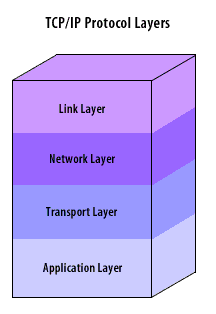The Four Layers of the TCP/IP Protocol
| Lesson 2 | The TCP/IP protocol in Distributed Computing |
| Objective | Four Layers of the TCP/IP protocol |
The TCP/IP model, often called the Internet Protocol Suite, provides the foundation for all modern network communication. It organizes networking functions into four distinct layers, each with specific roles that ensure data is transmitted efficiently and reliably across interconnected systems. Understanding these layers is essential for anyone administering or troubleshooting UNIX and Linux systems, where TCP/IP networking is intrinsic to daily operations.
Overview of the Four Layers
The TCP/IP model simplifies complex network communication by dividing responsibilities into manageable segments, known as layers. Each layer addresses a unique aspect of data transmission—from establishing physical connections to delivering user applications over the Internet.
- Link Layer (Network Interface Layer) – Handles the physical transmission of data over specific network media such as Ethernet, Wi-Fi, or fiber. It defines how bits are encoded into electrical or optical signals and how devices access the network medium.
-
Internet Layer – Provides logical addressing and routing across interconnected networks. The Internet Protocol (
IP) operates here, ensuring packets reach their destination regardless of the underlying hardware. Supporting protocols such asICMP(Internet Control Message Protocol) provide diagnostic and error reporting functions. -
Transport Layer – Manages end-to-end communication between processes running on different hosts. The two core protocols at this layer are:
TCP(Transmission Control Protocol) – Ensures reliable, ordered delivery through acknowledgments and retransmissions.UDP(User Datagram Protocol) – Provides fast, connectionless communication with minimal overhead, ideal for streaming and real-time services.
-
Application Layer – Represents the interface between the network and user applications. Protocols at this layer include:
HTTPfor web communicationSMTPfor emailDNSfor name resolutionSFTPorFTPSfor secure file transfers

Relationship Between the TCP/IP and OSI Models
Although the TCP/IP model defines only four layers, it aligns conceptually with the seven-layer OSI model:
- The Link Layer corresponds to the OSI Physical and Data Link layers.
- The Internet Layer aligns with the OSI Network layer.
- The Transport Layer matches the OSI Transport layer.
- The Application Layer encompasses the OSI Session, Presentation, and Application layers.
In practice, these distinctions are conceptual. Real-world networking stacks often merge or optimize functions across layers to improve performance and scalability.
Why Layered Architecture Matters
A layered approach allows developers to innovate at one level without disrupting the others. For example, a new physical medium such as fiber optics can be adopted without modifying TCP or HTTP. Similarly, new application protocols like HTTPS can be deployed without altering the underlying Internet infrastructure. This modularity is a core reason TCP/IP has endured and scaled since the early ARPANET.
Summary
The four-layer TCP/IP model remains a practical and elegant abstraction for understanding how data moves across networks. Its simplicity has enabled it to adapt to modern technologies such as cloud computing, mobile networks, and secure Internet services—demonstrating the robustness of its original design.